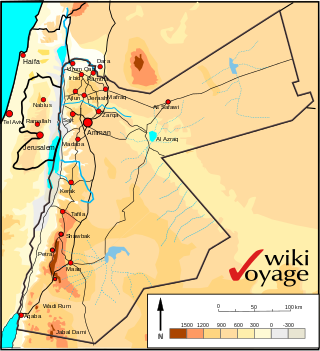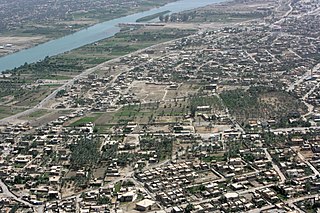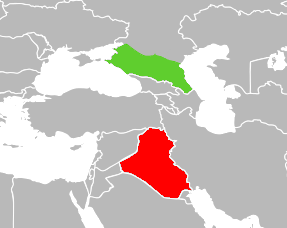
Jordan is situated geographically in West Asia, south of Syria, west of Iraq, northwest of Saudi Arabia, east of Palestine. The area is also referred to as the Middle or Near East. The territory of Jordan now covers about 91,880 square kilometres (35,480 sq mi).

The United Arab Republic was a sovereign state in the Middle East from 1958 until 1971. It was initially a political union between Egypt and Syria from 1958 until Syria seceded from the union following the 1961 Syrian coup d'état. Egypt continued to be known officially as the United Arab Republic until September 1971 when it was formally dissolved by Anwar Sadat.

The Bedouin, Beduin, or Bedu are pastorally nomadic Arab tribes who have historically inhabited the desert regions in the Arabian Peninsula, North Africa, the Levant, and Mesopotamia. The Bedouin originated in the Syrian Desert and Arabian Desert but spread across the rest of the Arab world in West Asia and North Africa after the spread of Islam. The English word bedouin comes from the Arabic badawī, which means "desert dweller", and is traditionally contrasted with ḥāḍir, the term for sedentary people. Bedouin territory stretches from the vast deserts of North Africa to the rocky sands of the Middle East. They are traditionally divided into tribes, or clans, and historically share a common culture of herding camels and goats. The vast majority of Bedouins adhere to Islam, although there are some fewer numbers of Christian Bedouins present in the Fertile Crescent.

The Arab world, formally the Arab homeland, also known as the Arab nation, the Arabsphere, or the Arab states, comprises a vast group of countries, mainly located in Western Asia and Northern Africa. While the majority of people in the Arab world are ethnically Arab, there are also significant populations of other ethnic groups such as Berbers, Kurds, Somalis and Nubians, among other groups. Arabic is used as the lingua franca throughout the Arab world.

Ramadi is a city in central Iraq, about 110 kilometers (68 mi) west of Baghdad and 50 kilometers (31 mi) west of Fallujah. It is the capital and largest city of Al Anbar Governorate which touches on Syria, Jordan and Saudi Arabia. The city extends along the Euphrates which bisects Al Anbar. Founded by the Ottoman Empire in 1879, by 2018 it had about 223,500 residents, near all of whom Sunni Arabs from the Dulaim tribal confederation. It lies in the Sunni Triangle of western Iraq.
Kahlan was one of the main tribal confederations of Saba' in Ancient Yemen. They are descended from Kahlan bin Saba bin Yishjab bin Yarub bin Qahtan.

Circassians, also called Cherkess or Adyghe, are an indigenous Northwest Caucasian ethnic group and nation native to the historical country-region of Circassia in the North Caucasus. As a consequence of the Circassian genocide perpetrated by the Russian Empire in the 19th century during the Russo-Circassian War, most Circassians were exiled from their homeland in Circassia to modern-day Turkey and the rest of the Middle East, where most of them are today. In the early 1990s, the Unrepresented Nations and Peoples Organization estimated that there are as many as 3.7 million Circassians in diaspora in over 50 countries.

Al-Hasakah Governorate is one of the fourteen governorates (provinces) of Syria. It is located in the far north-east corner of Syria and distinguished by its fertile lands, plentiful water, natural environment, and more than one hundred archaeological sites. It was formerly known as Al-Jazira Province. Prior to the Syrian Civil War nearly half of Syria's oil was extracted from the region. It is the lower part of Upper Mesopotamia.

The tribe of Shammar is a tribal Arab Qahtanite confederation, descended from the Tayy, which migrated into the northern Arabian Peninsula from Yemen in the second century. It is the largest branch of the Tayy, and one of the largest and most influential Arab tribes. The historical and traditional seat of the tribe's leadership is in the city of Ḥaʼil in what was the Emirate of Jabal Shammar in what is now Saudi Arabia. In its "golden age", around 1850, the Shammar ruled much of central and northern Arabia from Riyadh to the frontiers of Syria and the vast area of Upper Mesopotamia.

The Syrian Desert, also known as the North Arabian Desert, the Jordanian steppe, or the Badiya, is a region of desert, semi-desert and steppe covering 500,000 square kilometers of the Middle East, including parts of southern Syria, eastern Jordan, northern Saudi Arabia, and western Iraq. It accounts for 85% of the land area of Jordan and 55% of Syria. To the south it borders and merges into the Arabian Desert. The land is open, rocky or gravelly desert pavement, cut with occasional wadis.

The Tribes of Arabia or Arab tribes denote ethnic Arab tribes originating in the Arabian Peninsula. These tribes trace their ancestry to one of the two Arab forefathers, Adnan or Qahtan.

Kurdification is a cultural change in which people, territory, or language become Kurdish. This can happen both naturally or as a deliberate government policy.

Anizah or Anazah is an Arabian tribe in the Arabian Peninsula, Upper Mesopotamia, and the Levant.
The Banu Amir was a large and ancient Arab tribe originating from Western Arabia, that dominated Najd for centuries after the rise of Islam. The tribe is an Arab Adnanite tribe and its lineage is traced back to Adnan and Ishmael son of Abraham through Hawazin, and its original homeland was the border area between Nejd and Hejaz in Khurmah and Ranyah. Although the Banu Amir were engaged in a long war with the Quraysh before the appearance of Islam—manifesting in particular as the Fijar War—the tribe was characterized by giving late allegiance to Muhammad and his immediate successors. The tribe produced several well-known Arabic poets, the most famous of whom was Labid ibn Rabi'ah, an author of one of the Seven Hanged Poems. Other poets included Amir ibn al-Tufayl, an important tribal chief; al-Ra'i al-Numayri, an opponent of Jarir; and the female poet Layla al-Akhyaliyyah. The protagonists of the romantic saga of Layla wal Majnun, Qays and Layla, also belonged to Banu Amir.

The Arab world consists of 22 states. As of 2021, the combined population of all the Arab states was around 475 million people.

Christianity, which originated in the Middle East during the 1st century AD, is a significant minority religion within the region, characterized by the diversity of its beliefs and traditions, compared to Christianity in other parts of the Old World. Christians now make up approximately 5% of the Middle Eastern population, down from 13% in the early 20th century. Cyprus is the only Christian majority country in the Middle East, with Christians forming between 76% and 78% of the country's total population, most of them adhering to Eastern Orthodox Christianity. Lebanon has the second highest proportion of Christians in the Middle East, around 40%, predominantly Maronites. Egypt has the next largest proportion of Christians, at around 10% of its total population. Copts, numbering around 10 million, constitute the single largest Christian community in the Middle East.
Semaan is a Christian surname mainly found in the Levant area of the Middle East. It is derived from the Semitic root word/verb sema or shema, which means “to hear”; thus, the meaning of Semaan becomes “the one who hears or listens” in both Syriac Aramaic and Arabic. Its equivalent in Hebrew is שִׁמְעוֹן, which also has the same meaning. The Greek transliteration is Σιμων (Simon) or Συμεών (Symeon), and, when Latinized, it becomes Simon or Simeon.
Transjordan, the East Bank, or the Transjordanian Highlands, is the part of the Southern Levant east of the Jordan River, mostly contained in present-day Jordan.

Circassians in Iraq refer to people born in or residing in Iraq, that are of Circassian origin. Like all Iraqis, Circassians in Iraq faced various hardships in the modern era, as Iraq suffered wars, sanctions, oppressive regimes, and civil strife.

The Arab Belt was the Syrian Ba'athist government's project of Arabization of the north of the Al-Hasakah Governorate to change its ethnic composition of the population in favor of Arabs to the detriment of other ethnic groups, particularly Kurds.














